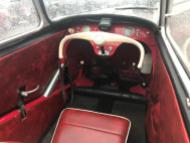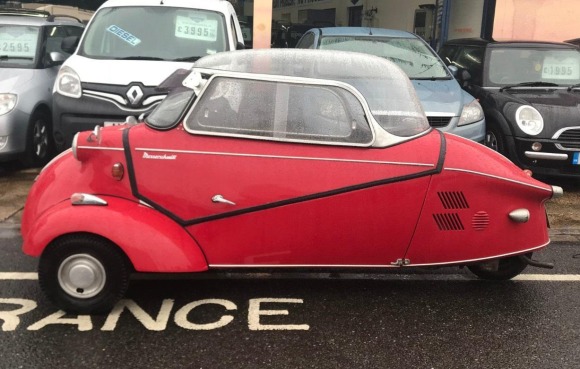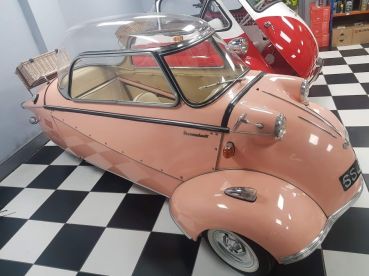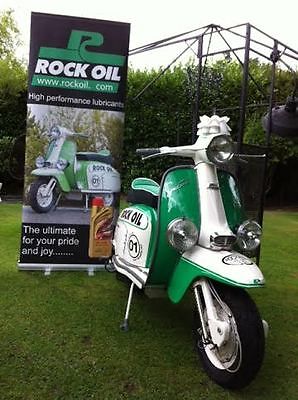
When the original Lambretta – The Model A – was released – it was with a very much with the ethos of producing a cheap transport option for post war Italy. The radical simplicity of these early machines – and the fairly swift refinement into the models B, C soon led to these models being adopted in large numbers. A more ‘luxury’ version of the model C was introduced with full panelling – The LC – The “L” in LC actually stands for “Lusso” – the Italian for “Luxury”.

For a while, Innocenti offered you a choice of models – basic or luxury – with the Model D selling alongside the full-framed LD. The fully panelled luxury option went on to define the way the world thought a Lambretta should look for all future models – until at maybe the introduction of the Luna range in the late 60’s. But the basic models continued to be popular amongst a couple of groups… the budget conscious, and racers. Racers loved the reduced weight and the convenient access to the engines… making customisation, tuning and roadside repairs easier and quicker. You can see what a Racing D looked like in this post from the archives (well April).
But we all know the Lambretta was made in other countries around the world, Including Argentina – where SIambretta had been selling Argentinean Lambrettas since 1954, starting by assembling Model A’s shipped from Italy. Following the Italian model of offering a basic (or “Standard”) and luxury or “Deluxe” model.
The Siambretta was very popular in it’s home market – even exporting to other South American countries such a Chile and Uruguay. But by the late 60’s, sales were waning. To reinvigorate them, they looked to the past, and popular “Standard” models… however, a cheap, panel-less back to basics model wouldn’t quite cut the mustard. They wanted something with a bit of ooomph. A sporty Standard, or indeed, a “Super Standard”.

The result of this was the Siambretta Super Standard 175 AV – the AV thought by many to be a nod to Innocenti’s sporty TV line – changing the Turismo (the “T” in TV) to Argentina – (so AV = Argentina Veloce, rather than Turismo Veloce) . This was the only model designed 100% in Argentina – albeit on the back of an existing Lambretta model, and was a reasonable success for Siambretta.

Although called a “Super Standard’, these look anything but Standard to those of us used to seeing the curvaceous lines of the ‘standard’ Series 2 Lambretta on which they were based. The changes are pretty obvious, even from a cursory inspection – cutdown legshields, a redesigned cutdown front mudguard, a missing ‘frame-loop’ with a redesigned toolbox and petrol tank split laterally along the frame. The missing frame-loop at the rear is compensated for by an additional boxed structure above the rear mudguard… the main function of which seems to be as a mount for a spare wheel, and the rear light. Now, I’m no scooter designer (other than in the amatuer way that we all are), but maybe a more successful option would be losing the pillion seat, and the new box section, and storing the spare behind the cutdown legshields… a rear light could be easily mounted on the frame, under the seat. The headset is a simplified affair with a bolt-on headlight. The horncasting is squared off, and rather unfortunate looking, in my humble opinion.
Some shots, from a magazine road test of the time, show that it’s perhaps a machine that looks better when being ridden than standing still;



Thanks to Darrin Slack for sending me these images, there’s more to come on the history of Siambretta, including some original press and advertising material.
Other information comes from the El Siambrettista blog – a blog all about the Siambretta in it’s various guises, and well worth checking out.
If you’re interested in South American Lammies, check out this post on the even more extreme Xispa model from Brazil.






























 If you want to take your mind off the US elections, here’s a picture of a couple pretty girls on a Lambretta. You’re welcome.
If you want to take your mind off the US elections, here’s a picture of a couple pretty girls on a Lambretta. You’re welcome. I’ve got a folder on my mac of pics I’ve collected over the years… I don’t know where most of them came from, but each of them must have a story behind them. I’ve done a Google image search on this one, with no joy – so if you’ve got any idea who this lot are please let me know! They’re clearly a mixed bunch of machines here, so not a Lambretta club – if they’re a club at all, and not just a random meet up! I’m guessing early 60’s from the S2 Lambrettas – (Vespa experts will know when that GS ‘came out’) though pre-mod or just ‘not mod’ with just ‘sensible’ accessories and proper riding gear! Number plate experts might be able to pin it down from the MN suffix… Isle of Man? Manchester? Does the structure in the background give any clues… is it a bus/coach station?
I’ve got a folder on my mac of pics I’ve collected over the years… I don’t know where most of them came from, but each of them must have a story behind them. I’ve done a Google image search on this one, with no joy – so if you’ve got any idea who this lot are please let me know! They’re clearly a mixed bunch of machines here, so not a Lambretta club – if they’re a club at all, and not just a random meet up! I’m guessing early 60’s from the S2 Lambrettas – (Vespa experts will know when that GS ‘came out’) though pre-mod or just ‘not mod’ with just ‘sensible’ accessories and proper riding gear! Number plate experts might be able to pin it down from the MN suffix… Isle of Man? Manchester? Does the structure in the background give any clues… is it a bus/coach station?





